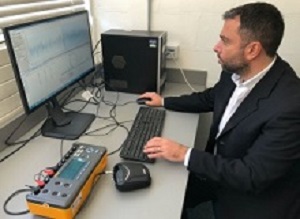Two pilot studies in the UK have found that using artificial intelligence (AI) the Currently Continuous Glucose Monitors (CGM) used by the UK's National Health Service (NHS) and often requiring twice-daily fingerprick tests, can detect hypoglycaemic events from raw ECG signals acquired with off-the-shelf non-invasive wearable sensors.
Currently Continuous Glucose Monitors (CGM) are available by the UK's National Health Service (NHS) for hypoglycaemia detection (sugar levels into blood or derma). They measure glucose in interstitial fluid using an invasive sensor with a little needle, which sends alarms and data to a display device. In many cases, they require calibration twice a day with invasive finger-prick blood glucose level tests.
However, Dr Leandro Pecchia's team at the University of Warwick have proved that using the latest findings of artificial intelligence (AI) they can detect hypo-glycaemic events from raw ECG signals acquired with off-the-shelf non-invasive wearable sensors.
Two pilot studies with healthy volunteers found the average sensitivity and specificity approximately 82% for hypoglycaemia detection, which is comparable with the current CGM performance, although non-invasive.
Dr Leandro Pecchia from the School of Engineering at the University of Warwick comments: "Fingerpicks are never pleasant and in some circumstances are particularly cumbersome. Taking fingerpick during the night certainly is unpleasant, especially for patients in paediatric age.
"Our innovation consisted in using artificial intelligence for automatic detecting hypoglycaemia via few ECG beats. This is relevant because ECG can be detected in any circumstance, including sleeping."
The figure shows the output of the algorithms over the time: the green line represents normal glucose levels, while the red line represents the low glucose levels. The horizontal line represents the 4mmol/L glucose value, which is considered the significant threshold for hypoglycaemic events. The grey area surrounding the continuous line reflects the measurement error bar.
The Warwick model highlights how the ECG changes in each subject during a hypoglycaemic event. The figure below is an exemplar. The solid lines represent the average heartbeats for two different subjects when the glucose level is normal (green line) or low (red line). The red and green shadows represent the standard deviation of the heartbeats around the mean.
A comparison highlights that these two subjects have different ECG waveform changes during hypo events. In particular, Subject 1 presents a visibly longer QT interval during hypo, while the subject 2 does not.
The vertical bars represent the relative importance of each ECG wave in determining if a heartbeat is classified as hypo or normal. From these bars, a trained clinician sees that for Subject 1, the T-wave displacement influences classification, reflecting that when the subject is in hypo, the repolarisation of the ventricles is slower.
In Subject 2, the most important components of the ECG are the P-wave and the rising of the T-wave, suggesting that when this subject is in hypo, the depolarisation of the atria and the threshold for ventricular activation are particularly affected. This could influence subsequent clinical interventions.
This result is possible because the Warwick AI model is trained with each subject's own data. Intersubjective differences are so significant, that training the system using cohort data would not give the same results. Likewise, personalised therapy based on our system could be more effective than current approaches.
Dr Leandro Pecchia comments: "The differences highlighted above could explain why previous studies using ECG to detect hypoglycaemic events failed. The performance of AI algorithms trained over cohort ECG-data would be hindered by these inter-subject differences."
"Our approach enable personalised tuning of detection algorithms and emphasise how hypoglycaemic events affect ECG in individuals. Basing on this information, clinicians can adapt the therapy to each individual. Clearly more clinical research is required to confirm these results in wider populations. This is why we are looking for partners."
Abstract
Tracking the fluctuations in blood glucose levels is important for healthy subjects and crucial diabetic patients. Tight glucose monitoring reduces the risk of hypoglycemia, which can result in a series of complications, especially in diabetic patients, such as confusion, irritability, seizure and can even be fatal in specific conditions. Hypoglycemia affects the electrophysiology of the heart. However, due to strong inter-subject heterogeneity, previous studies based on a cohort of subjects failed to deploy electrocardiogram (ECG)-based hypoglycemic detection systems reliably. The current study used personalised medicine approach and Artificial Intelligence (AI) to automatically detect nocturnal hypoglycemia using a few heartbeats of raw ECG signal recorded with non-invasive, wearable devices, in healthy individuals, monitored 24 hours for 14 consecutive days. Additionally, we present a visualisation method enabling clinicians to visualise which part of the ECG signal (e.g., T-wave, ST-interval) is significantly associated with the hypoglycemic event in each subject, overcoming the intelligibility problem of deep-learning methods. These results advance the feasibility of a real-time, non-invasive hypoglycemia alarming system using short excerpts of ECG signal.
Authors
Mihaela Porumb, Saverio Stranges, Antonio Pescapè, Leandro Pecchia
[link url="https://warwick.ac.uk/newsandevents/pressreleases/artificial_intelligence_ai"]University of Warwick material[/link]
[link url="https://www.nature.com/articles/s41598-019-56927-5"]Scientific Reports abstract[/link]

